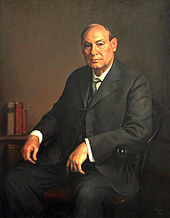A coalition government is a form of government in which
political parties cooperate, reducing the dominance of any one party
within that "coalition". The usual reason for this arrangement is that
no party on its own can achieve a majority in the election.
A coalition government might also be created in a time of national
difficulty or crisis (for example, during wartime or economic crisis) to
give a government the high degree of perceived political legitimacy or collective identity, it can also play a role in diminishing internal political strife. In such times, parties have formed all-party coalitions (national unity governments, grand coalitions). If a coalition collapses, a confidence vote is held or a motion of no confidence is taken.
Practice
When a general election does not produce a clear majority for a
single party, parties either form coalition cabinets, supported by a
parliamentary majority, or minority cabinets
which may consist of one or more parties. Cabinets based on a group of
parties that command a majority in parliament tend to be more stable and
long-lived than minority cabinets. While the former are prone to
internal struggles, they have less reason to fear votes of no
confidence. Majority governments based on a single party are typically even more stable, as long as their majority can be maintained.
Distribution
Countries which often operate with coalition cabinets include: the Nordic countries, the Benelux countries, Australia, Austria, Cyprus, France, Germany, Greece, India, Indonesia, Ireland, Israel, Italy, Japan, Kenya, Kosovo, Lithuania, Latvia, Lebanon, Nepal, New Zealand, Pakistan, Thailand, Trinidad and Tobago, Turkey and Ukraine. Switzerland has been ruled by a coalition of the four strongest parties in parliament from 1959 to 2008, called the "Magic Formula". Between 2010 and 2015, the United Kingdom also operated a formal coalition between the Conservative and the Liberal Democrat parties, but this was unusual: the UK usually has a single-party majority government.
Coalitions composed of few parties
United Kingdom
In the United Kingdom,
coalition governments (sometimes known as "national governments")
usually have only been formed at times of national crisis. The most
prominent was the National Government of 1931 to 1940. There were multi-party coalitions during both world wars.
Apart from this, when no party has had a majority, minority governments
normally have been formed with one or more opposition parties agreeing
to vote in favour of the legislation which governments need to function:
for instance the Labour government of James Callaghan formed a pact with the Liberals
from March 1977 until July 1978, after a series of by-election defeats
had eroded Labour's majority of three seats which had been gained at the
October 1974 election. However, in the run-up to the 1997 general election, Labour opposition leader Tony Blair was in talks with Liberal Democrat leader Paddy Ashdown
about forming a coalition government if Labour failed to win a majority
at the election; but there proved to be no need for a coalition as
Labour won the election by a landslide. The 2010 general election resulted in a hung parliament (Britain's first for 36 years), and the Conservatives, led by David Cameron, which had won the largest number of seats, formed a coalition with the Liberal Democrats
in order to gain a parliamentary majority, ending 13 years of Labour
government. This was the first time that the Conservatives and Lib Dems
had made a power-sharing deal at Westminster.
It was also the first full coalition in Britain since 1945, having been
formed 70 years virtually to the day after the establishment of Winston Churchill's wartime coalition,
Labour and the Liberal Democrats have entered into a coalition twice in the Scottish Parliament, as well as twice in the Welsh Assembly.
Germany
In Germany, for instance, coalition government is the norm, as it is rare for either the Christian Democratic Union of Germany together with their partners the Christian Social Union in Bavaria (CDU/CSU), or the Social Democratic Party of Germany
(SPD), to win an unqualified majority in a national election. Thus, at
the federal level, governments are formed with at least two parties. For
example, Helmut Kohl's CDU governed for years in coalition with the Free Democratic Party (FDP); from 1998 to 2005 Gerhard Schröder's SPD was in power with the Greens; and from 2009 Angela Merkel, CDU/CSU was in power with the FDP.
"Grand coalitions" of the two large parties also occur, but these
are relatively rare, as large parties usually prefer to associate with
small ones. However, if none of the larger parties can receive enough
votes to form their preferred coalition, a grand coalition might be
their only choice for forming a government. This was the situation in
Germany in 2005 when Angela Merkel became Chancellor: in early elections,
the CDU/CSU did not garner enough votes to form a majority coalition
with the FDP; similarly the SPD and Greens did not have enough votes to
continue with their formerly ruling coalition. A grand coalition
government was subsequently forged between the CDU/CSU and the SPD.
Partnerships like these typically involve carefully structured cabinets.
The CDU/CSU ended up holding the Chancellery
while the SPD took the majority of cabinet posts. Parties frequently
make statements ahead of elections which coalitions they categorically
reject, similar to election promises or shadow cabinets in other
countries.
In Germany, coalitions rarely consist of more than two parties (CDU and CSU, two allies which always form a single caucus,
are in this regard considered a single party). However, in the 2010s
coalitions on the state level increasingly included three different
parties, often FDP, Greens and one of the major parties or "red red green" coalitions of SPD, Linkspartei
and Greens. By 2016, the Greens have joined governments on the state
level in eleven coalitions in seven various constellations.
Examples of coalitions
Armenia
Armenia became an independent state in 1991, following the collapse of the Soviet Union.
Since then, many political parties were formed in it, who mainly work
with each other to form coalition governments. Currently the country is
governed by the My Step Alliance coalition after successfully gaining a majority in the National Assembly of Armenia following the 2018 Armenian parliamentary election.
Australia
In federal Australian politics, the conservative Liberal, National, Country Liberal and Liberal National parties are united in a coalition, known simply as the Coalition.
The Coalition has become so stable, at least at the federal level, that
in practice the lower house of Parliament has become a two-party house, with the Coalition and the Labor Party being the major parties. This coalition is also found in the states of New South Wales and Victoria. In South Australia and Western Australia the Liberal and National parties compete separately, while in the Northern Territory and Queensland the two parties have merged, forming the Country Liberal Party, in 1978, and the Liberal National Party, in 2008, respectively.
The other federal coalition has been:
- United Australia–Country–Independents coalition in 1940
- In Tasmania:
- In the Australian Capital Territory:
- Liberal–Independent coalition in 1998.
- Labor–Greens coalitions in 2001 and 2008.
Belgium
In Belgium, where there are separate Dutch-speaking and French-speaking parties for each political grouping, coalition cabinets of up to six parties are common.
Canada
In Canada, the Great Coalition was formed in 1864 by the Clear Grits, Parti bleu, and Liberal-Conservative Party. During the First World War, Prime Minister Robert Borden
attempted to form a coalition with the opposition Liberals to broaden
support for controversial conscription legislation. The Liberal Party
refused the offer but some of their members did cross the floor
and join the government. Although sometimes referred to as a coalition
government, according to the definition above, it was not. It was
disbanded after the end of the war.
As a result of the 1919 Ontario election, the United Farmers of Ontario and the Labour Party, together with three independent MLAs, formed a coalition that governed Ontario until 1923.
In British Columbia, the governing Liberals formed a coalition with the opposition Conservatives in order to prevent the surging, left-wing Cooperative Commonwealth Federation from taking power in the 1941 British Columbia general election. Liberal premier Duff Pattullo
refused to form a coalition with the third-place Conservatives, so his
party removed him. The Liberal–Conservative coalition introduced a
winner-take-all preferential voting system (the "Alternative Vote")
in the hopes that their supporters would rank the other party as their
second preference; however, this strategy did not take CCF second
preferences into account. In the 1952 British Columbia general election, to the surprise of many, the right-wing populist BC Social Credit Party
won a minority. They were able to win a majority in the subsequent
election as Liberal and Conservative supporters shifted their anti-CCF
vote to Social Credit.
Manitoba has had more formal coalition governments than any other
province. Following gains by the United Farmer's/Progressive movement
elsewhere in the country, the United Farmers of Manitoba
unexpectedly won the 1921 election. Like their counterparts in Ontario,
they had not expected to win and did not have a leader. They asked John Bracken, a professor in animal husbandry, to become leader and premier. Bracken changed the party's name to the Progressive Party of Manitoba.
During the Great Depression, Bracken survived at a time when other
premiers were being defeated by forming a coalition government with the
Manitoba Liberals (eventually, the two parties would merge into the Liberal-Progressive Party of Manitoba, and decades later, the party would change its name to the Manitoba Liberal Party).
In 1940, Bracken formed a wartime coalition government with almost
every party in the Manitoba Legislature (the Conservatives, CCF, and
Social Credit; however, the CCF broke with the coalition after a few
years over policy differences). The only party not included was the
small, communist Labor-Progressive Party, which had a handful of seats.
In Saskatchewan, NDP premier Roy Romanow formed a formal coalition with the Saskatchewan Liberals
in 1999 after being reduced to a minority. After two years, the newly
elected Liberal leader David Karwacki ordered the coalition be
disbanded, the Liberal caucus disagreed with him and left the Liberals
to run as New Democrats in the upcoming election. The Saskatchewan NDP was re-elected with a majority under its new leader Lorne Calvert, while the Saskatchewan Liberals lost their remaining seats and have not been competitive in the province since.
According to historian Christopher Moore,
coalition governments in Canada became much less possible in 1919, when
the leaders of parties were no longer chosen by elected MPs but instead
began to be chosen by party members. Such a manner of leadership
election had never been tried in any parliamentary system before.
According to Moore, as long as that kind of leadership selection process
remains in place and concentrates power in the hands of the leader, as
opposed to backbenchers, then coalition governments will be very
difficult to form. Moore shows that the diffusion of power within a
party tends to also lead to a diffusion of power in the parliament in
which that party operates, thereby making coalitions more likely.
During the 2008–09 Canadian parliamentary dispute,
two of Canada's opposition parties signed an agreement to form what
would become the country's second coalition government since Confederation if the minority Conservative government was defeated on a vote of non-confidence, unseating Stephen Harper as Prime Minister. The agreement outlined a formal coalition consisting of two opposition parties, the Liberal Party and the New Democratic Party. The Bloc Québécois agreed to support the proposed coalition on confidence matters for 18 months. In the end, parliament was prorogued by the Governor General, and the coalition dispersed before parliament was reconvened.
Denmark
From the creation of the Folketing in 1849 through the introduction of proportional representation in 1918, there were only single-party governments in Denmark. Thorvald Stauning formed his second government
and Denmark's first coalition government in 1929. With the exception of
a string of one-party governments during the 1970s, the norm since 1929
has been coalition governments. Every government from 1982 until the 2015 elections were coalitions. The most recent coalition was Løkke's third government, which was replaced by the one-party Frederiksen government in 2019.
When the Social Democrats under Stauning won 46% of the votes in the 1935 election,
this was the closest any party has gotten to winning an outright
majority in parliament. One party has thus never held a majority alone,
and even one-party governments since 1918 have needed the support
of at least one other party to govern. For example, the current
government consists only of the Social Democrats, but also relies on the
support of the Social Liberal Party, the Socialist People's Party, and the Red–Green Alliance.
Finland
In Finland,
no party has had an absolute majority in the parliament since
independence, and multi-party coalitions have been the norm. Finland
experienced its most stable government (Lipponen I and II) since independence
with a five-party governing coalition, a so-called "rainbow
government". The Lipponen cabinets set the stability record and were
unusual in the respect that both the centre-left (SDP) and radical
left-wing (Left Alliance) parties sat in the government with the major
centre-right party (National Coalition). The Katainen cabinet was also a rainbow coalition of a total of five parties.
India
Since India's Independence on 15 August 1947, Indian National Congress, the major political party instrumental in Indian independence movement, ruled the nation. The first Prime Minister Jawaharlal Nehru, second PM Lal Bahadur Shastri and the third PM Indira Gandhi, all were from the Congress party. However, Raj Narain, who had unsuccessfully contested election against Indira from the constituency of Rae Bareilly
in 1971, lodged a case, alleging electoral malpractices. In June 1975,
Indira was found guilty and barred by High Court from holding public
office for six years. In response, an ungracious Emergency was declared
under the pretext of national security. The next election's result was that India's first-ever coalition government was formed at the national level under the Prime Ministership of Morarji Desai, which was also the first non-Congress national government, which existed from 24 March 1977 to 15 July 1979, headed by the Janata Party,
an amalgam of political parties opposed to Emergency imposed between
1975 and 1977. As the popularity of Janata Party dwindled, Morarji Desai
had to resign and Charan Singh,
a rival of Desai became the fifth PM. However, due to lack of support,
this coalition government did not complete its five-year term.
Congress returned to the power in 1980 under Indira Gandhi, and later under Rajiv Gandhi as the 6th PM. However, the next general election of 1989 once again brought a coalition government under National Front,
which lasted until 1991, with two Prime Ministers, the second one being
supported by Congress. The 1991 election resulted in a Congress led
stable minority government for five years. The next 11th parliament
produced three Prime Ministers in two years and forced the country back
to the polls in 1998. The first successful coalition government in
India which completed the whole 5-year term was the Bharatiya Janata Party (BJP) led National Democratic Alliance with Atal Bihari Vajpayee as PM from 1999 to 2004. Then another coalition, Congress led United Progressive Alliance, consisting of 13 separate parties ruled India for two terms from 2004 to 2014 with Manmohan Singh as PM. However, in the 16th general election
in May 2014, BJP secured majority on its own (first party to do so
since 1984 election) and National Democratic Alliance came into power,
with Narendra Modi
as Prime Minister. In 2019, Narendra Modi got re-elected as Prime
Minister for the second time as National Democratic Alliance again
secured majority in the 17th general election.
Indonesia
As a result of the toppling of Suharto, political freedom is significantly increased. Compared to only three parties allowed to exist in the New Order era, a total of 48 political parties participated in the 1999 election, a total of 24 parties in the 2004 election, 38 parties in the 2009 election, and 15 parties in the 2014 election.
There are no majority winner of those elections and coalition
governments are inevitable. The current government is a coalition of
seven parties led by the PDIP and Golkar.
Ireland
In Ireland,
coalition governments are common; not since 1977 has a single party
formed a majority government. Coalition governments to date have been
led by either Fianna Fáil or Fine Gael. They have been joined in government by one or more smaller parties or independent members of parliament (TDs).
Ireland's first coalition government was formed after the 1948 general election,
with five parties and independents represented at cabinet. Before 1989,
Fianna Fáil had opposed participation in coalition governments,
preferring single-party minority government instead. It formed a
coalition government with the Progressive Democrats in that year.
The Labour Party has been in government on eight occasions. On all but one of those occasions, it was as a junior coalition party to Fine Gael. The exception was a government with Fianna Fáil from 1993 to 1994. The Government of the 31st Dáil (2011–16), though a traditional Fine Gael–Labour coalition, was a grand coalition of the two largest parties, as Fianna Fáil had fallen to third place in the Dáil.
The current government is minority Fine Gael government with Independents at cabinet, supported by a confidence and supply arrangement with Fianna Fáil.
Israel
A similar situation exists in Israel, which typically has at least 10 parties holding representation in the Knesset. The only faction to ever gain the majority of Knesset seats was Alignment, an alliance of the Labor Party and Mapam
that held an absolute majority for a brief period from 1968 to 1969.
Historically, control of the Israeli government has alternated between
periods of rule by the right-wing Likud
in coalition with several right-wing and religious parties and periods
of rule by the center-left Labor in coalition with several left-wing
parties. Ariel Sharon's formation of the centrist Kadima party in 2006 drew support from former Labor and Likud members, and Kadima ruled in coalition with several other parties.
Israel also formed a national unity government from 1984–1988.
The premiership and foreign ministry portfolio were held by the head of
each party for two years, and they switched roles in 1986.
Japan
Post-World War II Japan has historically been dominated by the Liberal Democratic Party, but there was a brief coalition government formed after the 1993 election following LDP's first loss of its overall House of Representatives
majority since 1955, winning only 223 out of 511 seats. The LDP
government was replaced by an eight-party coalition government, which
consisted of all of the previous opposition parties excluding the Japanese Communist Party, who together controlled 243 seats. Every Japanese government since then has been a coalition government in one way or another.
New Zealand
MMP was introduced in New Zealand in the 1996 election.
In order to get into power, parties need to get a total of 50% of the
121 seats in parliament – 61. Since no parties have ever gotten a full
majority, they must form coalitions with other parties. For example,
during the 2017 general election, Labour got 46 seats and New Zealand First got nine. The two formed a Coalition Government with confidence and supply from the Green Party which got eight seats.
Spain
Since 2015,
there are many more coalition governments than previously in
municipalities, autonomous regions and, since 2020 (coming from the November 2019 Spanish general election),
in the Spanish Government. There are two ways of conforming them: all
of them based on a program and its institutional architecture, one
consists on distributing the different areas of government between the
parties conforming the coalition and the other one is, like in the
Valencian Community,
where the ministries are structured with members of all the political
parties being represented, so that conflicts that may occur are
regarding competences and not fights between parties.
Coalition governments in Spain had already existed during the 2nd
Republic, and have been common in some specific Autonomous Communities
since the 80's. Nonetheless, the prevalence of two big parties overall
has been eroded and the need for coalitions appears to be the new normal
since around 2015.
Uruguay
Since the 1989 election, there have been 4 coalition governments, all including at least both the conservative National Party and the liberal Colorado Party. The first one was after the election of the blanco Luis Alberto Lacalle
and lasted until 1992 due to policy disagreements, the longest lasting
coalition was the Colorado-led coalition under the second government of Julio María Sanguinetti, in which the national leader Alberto Volonté was frequently described as a "Prime Minister", the next coalition (under president Jorge Batlle) was also Colorado-led, but it lasted only until after the 2002 Uruguay banking crisis, when the blancos abandoned the government. After the 2019 Uruguayan general election, the blanco Luis Lacalle Pou formed the coalición multicolor, composed of his own National Party, the liberal Colorado Party, the right wing populist Open Cabildo and the center left Independent Party.
Criticism
Advocates of proportional representation suggest that a coalition
government leads to more consensus-based politics, as a government
comprising differing parties (often based on different ideologies) need
to compromise about governmental policy. Another stated advantage is
that a coalition government better reflects the popular opinion of the electorate within a country.
Those who disapprove of coalition governments believe that such
governments have a tendency to be fractious and prone to disharmony, as
their component parties hold differing beliefs and thus may not always
agree on policy.
Sometimes the results of an election mean that the coalitions which are
mathematically most probable are ideologically infeasible, for example
in Flanders or Northern Ireland. A second difficulty might be the ability of minor parties to play "kingmaker"
and, particularly in close elections, gain far more power in exchange
for their support than the size of their vote would otherwise justify.
Coalition governments have also been criticized for sustaining a consensus
on issues when disagreement and the consequent discussion would be more
fruitful. To forge a consensus, the leaders of ruling coalition parties
can agree to silence their disagreements on an issue to unify the
coalition against the opposition. The coalition partners, if they
control the parliamentary majority, can collude to make the
parliamentary discussion on the issue irrelevant by consistently
disregarding the arguments of the opposition and voting against the
opposition's proposals — even if there is disagreement within the ruling
parties about the issue.
Powerful parties can also act in an oligocratic
way to form an alliance to stifle the growth of emerging parties. Of
course, such an event is rare in coalition governments when compared to two-party systems, which typically exist because of stifling of the growth of emerging parties, often through discriminatory nomination rules regulations and plurality voting systems, and so on.
A single, more powerful party can shape the policies of the
coalition disproportionately. Smaller or less powerful parties can be
intimidated to not openly disagree. In order to maintain the coalition,
they would have to vote against their own party's platform in the
parliament. If they do not, the party has to leave the government and
loses executive power. However, this is contradicted by the "kingmaker"
factor mentioned above.













